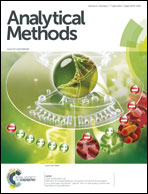Improving the quantitative accuracy of surface-enhanced Raman spectroscopy by the combination of microfluidics with a multiplicative effects model
Abstract
In this contribution, the combination of polydimethylsiloxane microfluidics with a recently developed multiplicative effects model for surface-enhanced Raman spectroscopy (MEMSERS) has been proposed to improve the accuracy and precision of quantitative SERS assays based on silver nanocolloids. The performance of the proposed method has been tested on two proof-of-concept systems and another real system (i.e., quantification of Rhodamine 6G by both internal standard addition and internal standard tagging detection modes, quantification of malachite green in fishpond water by internal standard addition detection mode). The average relative prediction error values of the proposed method for the test samples of the above three systems were 6.0%, 8.6% and 8.4% respectively. Conservatively speaking, these results demonstrated that accurate quantitative SERS analysis with an average relative prediction error less than 10% can be expected through the combination of microfluidics with the MEMSERS calibration model.


 Please wait while we load your content...
Please wait while we load your content...